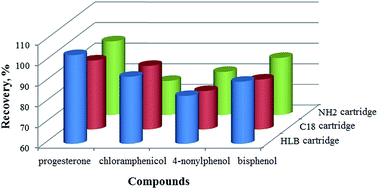Simultaneous determination of endogenous hormones and exogenous contaminants in infant formula powdered milk by salting-out assisted liquid–liquid extraction combined with solid-phase extraction purification and UPLC-MS/MS
Abstract
A robust and rapid ultrahigh performance liquid chromatography-tandem mass spectrometry (UPLC-MS/MS) method was developed for the simultaneous determination of four endogenous hormones and exogenous contaminants including progesterone, bisphenol A (BPA), 4-nonylphenol (4-NP) and chloramphenicol (CAP) in infant formula powdered milk. After adding isotope internal standards, the samples were first extracted with ethyl acetate–cyclohexane and then extracted by a dissolution–salting out-ethyl acetate extraction method (anhydrous sodium sulfate was used as the salt) for enhanced extraction of target analytes. Subsequently, the extraction solution was concentrated and purified by using a HLB solid phase extraction (SPE) cartridge (150 mg/6 mL, 30 μm, Waters Co., USA). Four target analytes were separated on a Phenomenex kinetex C18 column (100 mm × 3.0 mm, 2.6 μm) by gradient elution with methanol and water as mobile phases, detected by MS/MS in multiple reaction monitoring (MRM) mode and quantified by the internal standard method with progesterone-d9, BPA-d4, CAP-d5, and 4-n-NP-d4 as the isotope internal standards. The total time for the detection was 7 min. The developed method was validated in terms of sensitivity, linearity and range, recovery, matrix effect and precision. The results indicated that four target analytes displayed excellent linearity in their corresponding concentration ranges, with favorable correlation coefficients greater than 0.99. The limits of quantitation (LOQs) for these target analytes were in the range of 0.1–2.5 μg kg−1. The mean recoveries were calculated at three concentration levels spiked in negative infant formula powdered milk samples, and the values were found between 81.9% and 103% with relative standard deviation (RSD) values ranging from 2.9% to 7.0% for intra-day precision (n = 6) and ranging from 5.8% to 8.0% for inter-day precision (n = 5). The validated method was successfully applied to determine the concentrations of target analytes in real samples, and progesterone and 4-NP were respectively detected in 73 and 24 samples with concentrations in the range of 1.5–90.5 μg kg−1 and 13.5–36.8 μg kg−1, respectively. Fortunately, BPA and CAP were detected in none of the tested samples.



 Please wait while we load your content...
Please wait while we load your content...